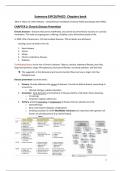Summary EIPCD/PAICD Chapters book
(Bret A. Boyer, M. Indira Paharia - Comprehensive handbook of clinical health psychology-John Wiley)
CHAPTER 3: Chronic Disease Prevention
Chronic diseases = Diseases that persist indefinitely, and cannot be prevented by vaccines or cured by
medication. This leads to ongoing pain, suffering, disability, and a diminished quality of life.
In 2000: 45% of Americans, 21% had multiple diseases. 70% of deaths are attributed.
Leading causes of death in the US:
1. Heart disease
2. Cancer
3. Stroke
4. Chronic respiratory diseases
5. Diabetes
Contributing factors to the rise of chronic diseases: Tobacco, obesity, sedentary lifestyle, poor diet,
large food portions, longer life expectancy, fast-paced lifestyle, increased pollution, and fast food.
➔ The suggestion is that behavioral and environmental influences have a larger role than
biological ones.
Disease prevention has three levels:
1. Primary: Directly addresses the causes of diseases. Carried out before disease, preventing its
occurrence.
o Lifestyle changes, patient education
2. Secondary: Early detection and treatment of diseases before a full-blown illness develops.
o Screenings
o Treatment regimen adherence
3. Tertiary: prevent recurrence or progression of disease that has already occurred.
o Chemotherapy
o Early screening for diabetes complications
o Smoking cessation for COPD Modifiable risk factors are important when genetic risk
factors are already present (e.g. family history)
1
,Four pillars of primary intervention (4Ps):
1. Tobacco cessation
2. Weight loss
3. Healthy diet
4. Regular exercise
Reduce the probability of developing chronic disease:
- Hyperlipidemia (high blood cholesterol)
- Hypertension (high blood pressure)
Smoking:
- Causes several types of cancer, heart disease, and COPD, and contributes to getting a stroke.
- Responsible for 80-90% of COPD deaths, 90% of lung cancer deaths
Weight:
- Obesity: the leading cause of death > increases risk of diabetes type 2, heart strokes,
hypertension, osteoarthritis, colon and breast cancer, sleep apnea, and depression.
- 20-30% of coronary heart disease deaths related
- 6x more chance to develop hypertension, 10x more risk on diabetes
Diet:
- Implicated in hyperlipidemia, hypertension, CVD, certain cancers, and diabetes type 2.
- Too much saturated fat (e.g. red meat) > increase LDL (bad cholesterol) levels.
- Fruit & vegetables protective effect against CVD and cancer
Leading causes of death:
1. Cardiovascular disease (CVD)
o Hearth disease (CHD)
o Stroke (cerebrovascular accident) = disrupted blood flow to the brain (blocked vessel)
- Modifiable risk factors:
o 4Ps: smoking ~ buildup cholesterol on artery walls > blood clots
o hyperlipidemia
o Hypertension: increased pressure on artery walls
o Diabetes: atherosclerosis (hardening arteries) + increase blood pressure and
cholesterol levels.
- 80% of heart attacks can be prevented by lifestyle changes
2. Cancer:
- 50% can be prevented by quitting tobacco (90% cause lung cancer) & bad diet & exercise
- Screening very important (mammograms and pap tests), HPV vaccine
o Removal of precancerous cells
3. Chronic obstructive pulmonary disease (COPD)
- Tabacco (80-90% cause) → cessation most effective
4. Type 2 diabetes mellitus:
- Cause of death & amputations, blindness, and end-stage renal disease (i.e. kidney failure).
2
, - High blood glucose levels (insufficient insulin production/action)
- Modifiable risk factors:
o 4Ps → especially pre-diabetes. But also managing blood glucose when you have the
disease.
o Control blood pressure and cholesterol levels
5. Hyperlipidemia: High blood cholesterol.
- Three of the 4Ps (weight loss, exercise, diet)
6. Hypertension: High blood pressure
- Silent killer: no symptoms often
o Primary hypertension: Combi genetic and environment
o Secondary ‘’: Result of another medical condition or medication
- 4Ps, BMI
- Stress > increased heart rate > negative impact heart and blood vessels
Disparities: Low SES/ minority group: greater disadvantage. Lack of insurance, poverty, language
barriers, racial discrimination.
Economic relevance:
- Chronic diseases account for a big part of expenditures.
- CEA (cost-effectiveness analysis): Relation between the financial investment of the program
and its clinical outcomes.
o Quality-adjusted life years (Qualys)
o Tobacco cessation gold standard
- Lack of insurance coverage > barrier to the delivery of preventative services
Health psychology: Beck’s cognitive triad: Depressed persons will experience negative thoughts
about the self, world, and future. → undermines the ability to engage in healthy behaviors.
Psychological models & theories:
The transtheoretical model (TTM): Prochaska and DiClemente (1982)
5 common processes of change from analyzing therapeutic systems:
1. Consciousness raising = Gather information about oneself and the problem.
2. Choosing = Increased awareness of healthy alternatives
3. Catharsis = Emotional expression of the problem behavior and process of change
➔ All happens within the person
4. Conditional stimuli = Stimulus control and counter conditioning
5. Contingency control = Use positive reinforcement from oneself and others and
reevaluate how problem behavior impacts the image and environment.
➔ All more in external environment forces
They eventually identified six stages of change (SOC):
1. Precontemplation: Not considering change, no problem, avoid information
2. Contemplation: Aware problem. Ambivalent about change.
3. Preparation: Decided to change, planning strategy. No action yet/
4. Action: Implement a plan
5. Maintenance: Sustain new behaviors
3





